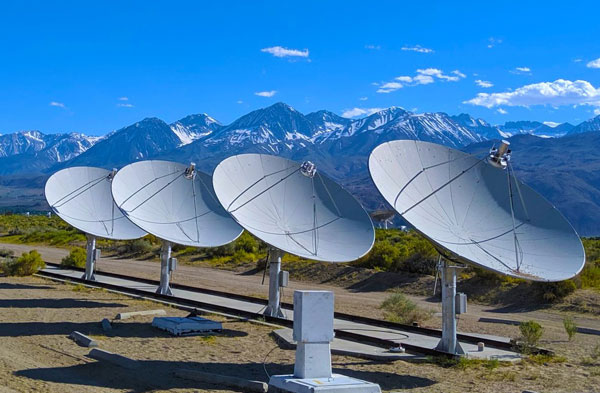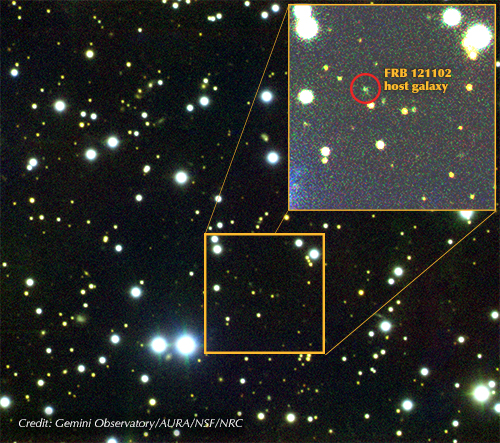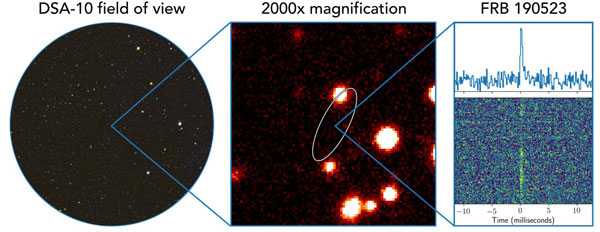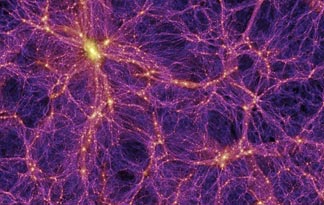Astronomers have narrowed down the location of a third "fast radio burst" to a galaxy very like the Milky Way.
Just one week after astronomers announced an incredible feat — identifying the galaxy that hosted a flash of radio waves that lasted only a fraction of a second — an independent team has done it again. The results take us one step closer to understanding the origins of the mysterious fast radio bursts.
Vikram Ravi (Caltech) and colleagues report July 2nd in Nature that they have pinpointed the source of fast radio burst 190523 via a technique called radio interferometry. The radio waves appear to come from a massive galaxy that’s much like the Milky Way.

Caltech / OVRO / G. Hallinan
Where do Fast Radio Bursts Come From?
Fast radio bursts (FRBs) are millsecond-long flashes of radio waves that sweep downward in frequency — an indication that they’ve traveled billions of light-years from their source to Earth. But here’s the rub: Astronomers have no real idea what the sources of FRBs are.
Given the huge distances involved, it’s unlikely that astronomers will ever image the sources themselves, but a good start is to home in on the sources’ locations; that is, to understand what kind of galaxies host them.

Gemini Observatory / AURA / NSF / NRC
The first FRB that astronomers ever pinned down was FRB 121102. This source was unusual because — unlike the vast majority of FRBs — it repeated. The many pulses gave astronomers the opportunity to locate the source, which lies within a large star formation region in a dwarf galaxy 3 billion light-years away. The repeating bursts and the high rate of star formation were both consistent with a scenario where the birth of a highly magnetized neutron star, known as a magnetar, sets off a flash of radio waves.
The second localized FRB, though, countered that scenario. FRB 180924 came from an aging galaxy, where essentially zero stars are being born. Since neutron stars form when massive, fast-burning stars collapse, the magnetar scenario is basically ruled out, at least for this source.
Now, Ravi’s team has used an array of 10 radio dishes, part of a prototype for the upcoming Deep Synoptic Array at the Owens Valley Radio Observatory, to quickly home in on a third burst, FRB 190523.

Caltech / OVRO / V. Ravi
A deep image of the surrounding field, taken later with the Keck I telescope, shows only one galaxy, PSO 1207.0643+72.4708. The galaxy is massive, roughly Milky Way-sized with a Milky Way-like star formation rate of about 1 Sun per year. If this is indeed the source’s home, its radio waves traveled more than 6 billion light-years to Earth.
If the host galaxy is like the Milky Way, that begs the question: Could our galaxy ever host one of these mysterious bursts? Eventually, Ravi says: “The lower limit on the rate in a Milky Way-like galaxy is one every 100 years. But we also think that FRBs are beamed, so that there are probably heaps that occur where we don’t see, because they’re pointed elsewhere. So the rate could be much higher.”
Such a burst would produce radio waves at a rate a billion times that of the Sun — impressive, to be sure, but not compared to what humans make: “That’s only as bright as a typical mobile phone at a distance of 10 meters,” Ravi says.
Fast Radio Burst Sources and the In-between
“Interestingly, both host galaxies of FRB 180924 and FRB 190523 are more similar to each other than they are to the host of FRB121102 (the repeater),” says Keith Bannister (CSIRO), who led the team that found the host galaxy of the FRB 180924.
The magnetar explanation also seems unlikely for FRB 190523, then, and it’s tempting to conclude that different scenarios apply for repeating and non-repeating bursts. But it’s important to note that, while no additional radio flashes have been detected from either source, it’s still possible they could repeat. The better we can pinpoint FRBs, the more conclusive the results will be.

Springel & others / Virgo Consortium
“We localized our FRB 180924 to an area about 1,000 times smaller than the FRB 190523,” says Bannister. But, he notes, the newer burst comes from much farther away. “It’s exciting that they have localized a burst from such a distant galaxy.”
A distant source is useful because, in addition to wanting to understand what generates these powerful flashes of radio waves, astronomers also want to use them to study the hot, sparse gas between galaxies. This practically unseeable gas holds most of the universe’s “normal” (i.e., not dark) matter and helps form the large-scale “web” that shapes the cosmos, and studying it is vital to understanding how galaxies grow.
As astronomers apply new radio telescopes (or rather, prototypes of still-larger telescopes to come) toward finding new fast radio bursts, the field is starting to yield some answers — and lots more questions.
 1
1









Comments
Anthony Barreiro
July 4, 2019 at 6:06 pm
If I'm reading the coordinates correctly, PSO 1207.0643+72.4708 is just north of the tip of Draco's tail, east of the line between the pointer stars of the big dipper and the north star.
You must be logged in to post a comment.
You must be logged in to post a comment.